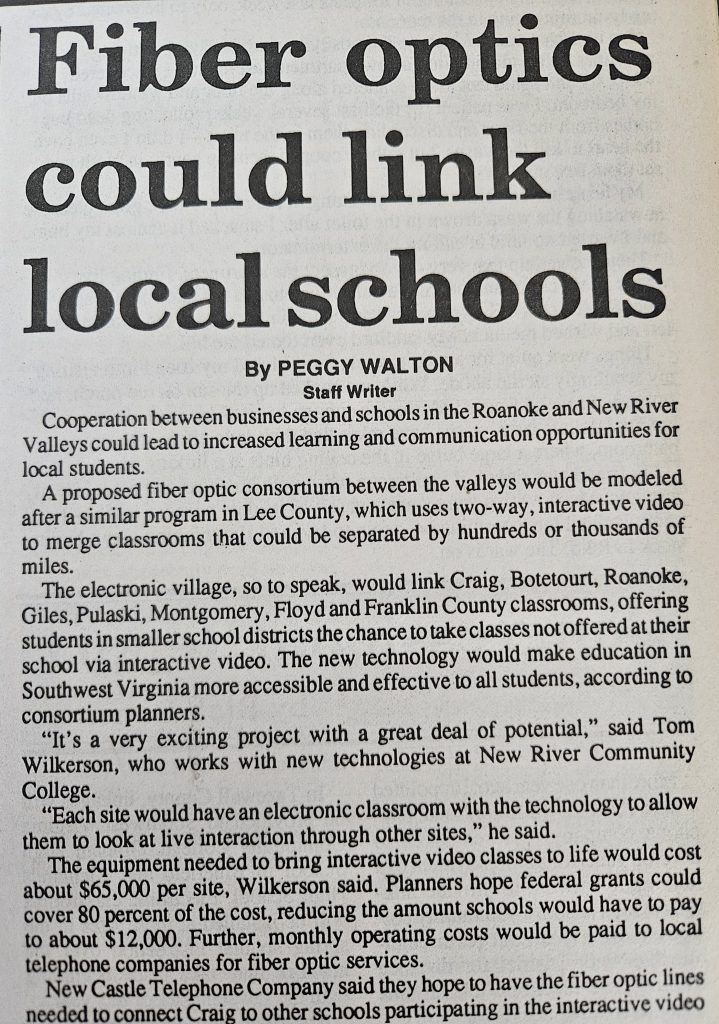 From the 1994 editions of the New Castle Record
From the 1994 editions of the New Castle Record
Cooperation between businesses and schools in the Roanoke and New River Valleys could lead to increased learning and communication opportunities for,” he said. local students.
A proposed fiber optic consortium between the valleys would be modeled after a similar program in Lee County, which used two-way, interactive video to merge classrooms that could be separated by hundreds or thousands of miles.
The electronic village, so to speak, would link Craig, Botetourt, Roanoke, Giles, Pulaski, Montgomery, Floyd, and Franklin County classrooms, offering students in smaller school districts the chance to take classes not offered at their school via interactive video. The new technology would make education in Southwest Virginia more accessible and effective to all students, according to consortium planners.
“It’s a very exciting project with a great deal of potential,” said Tom Wilkerson, who works with new technologies at New River Community College.
“Each site would have an electronic classroom with the technology to allow them to look at live interaction through other sites.
The equipment needed to bring interactive video classes to life would cost about $65,000 per site, Wilkerson said. Planners hope federal grants could cover 80 percent of the cost, reducing the amount schools would have to pay to about $12,000. Further, monthly operating costs would be paid to local telephone companies for fiber optic services.
New Castle Telephone Company said they hope to have the fiber optic lines needed to connect Craig to other schools participating in the interactive video system in place within a year.
“We’re gonna be working with the schools as we implement fiber optics,” said New Castle Telephone Manager Jerry Harms. “We will be meeting with them to see what their needs will be.”
The fiber optic system will also make a global computer system available to participating schools.
“It’s 24-hour access to the world,” said Wilkerson.
Internet and universal electronic mail would make it possible for Craig students to check the stock market in Japan or communicate directly with local or international politicians.
“If we can tie these two things together, they can have access to all of that as well.”
The new technology should contribute greatly to destroying educational disparities in Virginia.
“Through technology, we can break down a lot of these barriers and fight disparity,” Wilkerson said.
Elementary and secondary schools in the region would be connected to local colleges, including Virginia Tech, Virginia Western Community College, and Radford University. An electronic education and communication system is already in use in Blacksburg, mostly through Virginia Tech. The Blacksburg Electronic Village brings town residents and Tech-affiliated people instant information and communication through Internet and Gopher, a software tool.
Free public access terminals are available at the public library, so participants need not own a personal computer, according to BEV director Andy Cohill. He said the Village hopes to see all schools in Montgomery County connected through fiber optics within three or four years, with help from BEV, Tech and Bell Atlantic.
In Craig, fiber optic line is already laid along a portion of Virginia 42. Pembroke Telephone Cooperative said they would be willing to work with area phone companies and schools to expand fiber optic capability in the region so electronic classrooms can become a reality.
“That technology is readily available today,” said Pembroke Co-op Manager Stanley Cumbee.
Congressman Rick Boucher has been instrumental in attaining grants for improved technology in schools in Southwest Virginia and is expected to be a major asset in the fight for federal funding for fiber optic linkups.
The Appalachian Regional Commission is awarding $370,000 in grants to the Southwest Virginia Education and Training Network, Inc. to buy new video cameras, monitors and interface equipment for a network of electronic classrooms. It is not clear yet whether the proposed consortium of Roanoke and New River Valley schools will receive any funding from this program.
-Prepared By Lisa King


